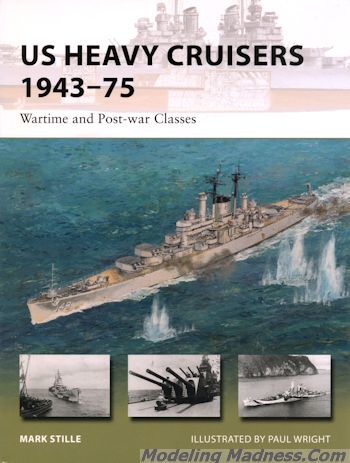 I
always find the New Vanguard ship books from Osprey to be a great read and this
one is no exception. It covers the war-time and post war builds and use of US
heavy cruisers. Few realize that these gun ships were in use up into the the
Vietnam war and beyond. They were particularly useful in both Korea and Vietnam,
performing basically the same missions as they did in World War II, which was
escort and shore bombardment. Their 8 inch guns were able to hit quite far
inland, a perfect platform for both 'softening up' areas for landing and hitting
targets several miles inland. An interesting fact is that no war-time build US
heavy cruiser ever saw ship to ship action and only one was damaged by a
Japanese offensive action, in this case the USS Canberra which was hit by a
torpedo from a Jill torpedo bomber while operating off Taiwan.
I
always find the New Vanguard ship books from Osprey to be a great read and this
one is no exception. It covers the war-time and post war builds and use of US
heavy cruisers. Few realize that these gun ships were in use up into the the
Vietnam war and beyond. They were particularly useful in both Korea and Vietnam,
performing basically the same missions as they did in World War II, which was
escort and shore bombardment. Their 8 inch guns were able to hit quite far
inland, a perfect platform for both 'softening up' areas for landing and hitting
targets several miles inland. An interesting fact is that no war-time build US
heavy cruiser ever saw ship to ship action and only one was damaged by a
Japanese offensive action, in this case the USS Canberra which was hit by a
torpedo from a Jill torpedo bomber while operating off Taiwan.
Since these were no longer constrained by treaty, these ships exceeded
the 10,000 ton limit of earlier heavy cruisers, some of them getting quite
large. There were four main classes of heavy cruisers; the Baltimore class,
Oregon class, Des Moines class and the Alaska class. This latter class of ships
is often mistakenly called a battle cruiser, but in reality it was just a big
gun heavy cruiser. Two of the class saw action late in the war while one was
launched, but cancelled after being 84% complete and later scrapped, as were
almost all of these ships.
Two of these ships were later converted to missile cruisers, the USS Chicago and
USS Albany, while one served until 1975, the USS Newport News. Only one heavy
cruiser anywhere is the world was preserved and that is the USS Salem, a ship
that had 'low miles' on her and is now on display in Quincy,
Massachusetts.
In line with other books of this series, we are given a look at what
went into the development of these ships and the various designs. This is
followed by a look at the weapons and other systems of the ships, followed by a
run-down of each of the classes and the ships that were both built and planned.
Their war time and peace time records are also covered. This is topped off by an
analysis of the ships in terms of how they performed their missions. In all, it
makes for an excellent book on the subject and one that needs to be on the shelf
of any ship modeler and enthusiast.
September 2014
For more on the complete line of Osprey books,
visit http://ospreygrp.com. In the US, it is
Osprey Direct at 44-02 23rd St, Suite 219, Long Island City, NY 11101., where you can
get a catalogue of available books.
If you would like your product reviewed fairly and
fairly quickly, please
contact
the editor or see other details in the
Note to
Contributors.
 I
always find the New Vanguard ship books from Osprey to be a great read and this
one is no exception. It covers the war-time and post war builds and use of US
heavy cruisers. Few realize that these gun ships were in use up into the the
Vietnam war and beyond. They were particularly useful in both Korea and Vietnam,
performing basically the same missions as they did in World War II, which was
escort and shore bombardment. Their 8 inch guns were able to hit quite far
inland, a perfect platform for both 'softening up' areas for landing and hitting
targets several miles inland. An interesting fact is that no war-time build US
heavy cruiser ever saw ship to ship action and only one was damaged by a
Japanese offensive action, in this case the USS Canberra which was hit by a
torpedo from a Jill torpedo bomber while operating off Taiwan.
I
always find the New Vanguard ship books from Osprey to be a great read and this
one is no exception. It covers the war-time and post war builds and use of US
heavy cruisers. Few realize that these gun ships were in use up into the the
Vietnam war and beyond. They were particularly useful in both Korea and Vietnam,
performing basically the same missions as they did in World War II, which was
escort and shore bombardment. Their 8 inch guns were able to hit quite far
inland, a perfect platform for both 'softening up' areas for landing and hitting
targets several miles inland. An interesting fact is that no war-time build US
heavy cruiser ever saw ship to ship action and only one was damaged by a
Japanese offensive action, in this case the USS Canberra which was hit by a
torpedo from a Jill torpedo bomber while operating off Taiwan.